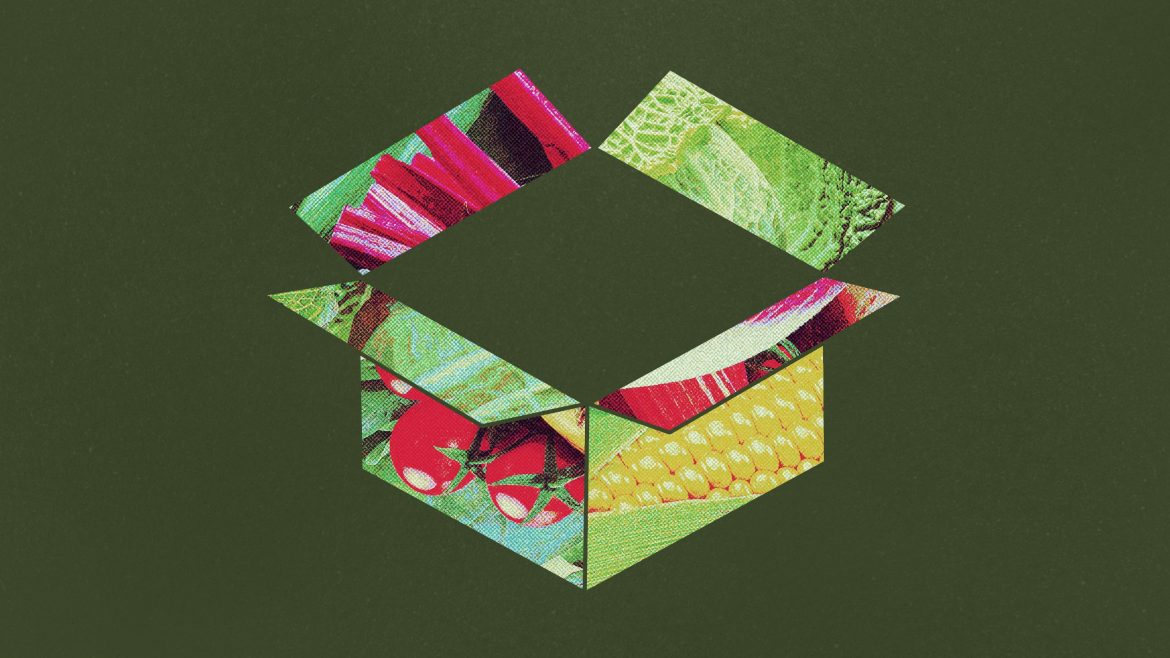Millions of Americans might soon have mail from Robert F. Kennedy Jr. The health secretary—who fiercely opposes industrial, ultraprocessed foods—now wants to send people care packages full of farm-fresh alternatives. They will be called “MAHA boxes.”
For the most part, MAHA boxes remain a mystery. They are mentioned in a leaked draft of a much-touted report that the Trump administration is set to release about improving children’s health. Reportedly, the 18-page document—which promises studies on the health effects of electromagnetic radiation and changes in how the government regulates sunscreen, among many other things—includes this: “MAHA Boxes: USDA will develop options to get whole, healthy food to SNAP participants.” In plain English, kids on food stamps might be sent veggies.
The idea might seem like a throwaway line in a wish list of policies. (Kush Desai, a deputy White House press secretary, told me that the leaked report should be disregarded as “speculative literature.”) But MAHA boxes are also referenced in the budget request that President Donald Trump sent Congress in May. In that document, MAHA boxes full of “commodities sourced from domestic farmers and given directly to American households” are proposed as an option for elderly Americans who already get free packages of shelf-stable goods from the government. When I asked the Department of Health and Human Services for more information about MAHA boxes, a spokesperson referred me back to the White House; the Department of Agriculture, which runs the food-stamp program, did not respond.
MAHA boxes are likely to come in some form or another. Some of the packages might end up in the trash. Lots of people, and especially kids, do not enjoy eating carrots and kale. Just 10 percent of U.S. adults are estimated to hit their daily recommended portion of vegetables. But if done correctly, MAHA boxes could do some real good.
For years, nutrition experts have been piloting similar programs. A recent study that provided diabetic people with healthy meal kits for a year found that their blood sugar improved, as did their overall diet quality. Another, which provided people with a delivery of fruits and vegetables for 16 weeks, showed that consumption of these products increased by nearly half a serving a day. It makes sense: If healthy food shows up at your door, you’re probably going to eat it. “Pretty much any American is going to benefit from a real healthy food box,” Dariush Mozaffarian, the director of the Tufts Food Is Medicine Institute, told me.
Sending people healthy food could be a simple way to deal with one of the biggest reasons why poor Americans don’t eat more fruits and veggies. The food-stamp program, otherwise known as SNAP, provides enrollees with a debit card they can use for food of their choosing—and a significant portion of SNAP dollars goes to unhealthy foods. Research finds that has less to do with people having a sweet tooth than it does the price of a pound of brussels sprouts. Several studies have found that, for food-stamp recipients, price is one of the biggest barriers to eating healthy. Many states already have incentives built into SNAP to encourage consumption of fruits and vegetables. MAHA boxes would be an even more direct nudge.
Most nutrition experts I spoke with for this story were much more supportive of MAHA boxes being sent to Americans in addition to food stamps than as a replacement for them. Exactly how the care packages would fit into other food-assistance programs isn’t yet clear. Despite its shortcomings, SNAP is very effective at limiting hunger in America. Shipping heavy boxes of produce to the nation’s poor is a much bigger undertaking than putting cash on a debit card.
There’s also the question of what exactly these MAHA boxes will include. If the “whole, healthy food” in each care package includes raw milk and beef tallow—which Kennedy has promoted—that would only worsen American health. (His own eating habits are even more questionable: Kennedy once said that he ate so many tuna sandwiches that he developed mercury poisoning.) In May, after the Trump administration mentioned MAHA boxes in its budget request, a White House spokesperson told CBS News that the packages would be similar to food boxes that the first Trump administration sent during the pandemic in an effort to connect hungry families with food that would otherwise go to waste. According to a letter signed by Trump that was sent to recipients, each box was supposed to come with “nutritious food from our farmers.” News reports at the time suggested that wasn’t always the case. One recipient reportedly was shipped staples such as onions, milk, some fruit, and eggs, along with seven packages of hot dogs and two blocks of processed cheese. Another described their box as “a box full of old food and dairy and hot dogs.”
[Read: America stopped cooking with tallow for a reason]
The COVID-era program did eventually deliver some 173 million food boxes. But it was still a failure, Gina Plata-Nino of the Food Research & Action Center, an organization that advocates for people on food-assistance programs, told me. The logistics were such a mess that they prompted a congressional investigation. Nonprofits, which helped distribute the packages, received “rotten food and wet or collapsing boxes,” investigators were told. And the setup of the program was apparently so rushed that the government did not bother to check food distributors’ professional references; investigators concluded that a “company focused on wedding and event planning without significant food distribution experience” was awarded a $39 million contract to transport perishables to food banks.
This time around, the White House doesn’t have to navigate the urgency of a sudden pandemic in its planning. But questions remain about who exactly will be responsible for getting these boxes to millions of Americans around the country. The White House will likely have to partner with companies that have experience shipping perishable items to remote areas of the country. And although the White House budget says that MAHA boxes will replace a program that primarily provides canned foods to seniors through local food banks, it remains to be seen whether these organizations would have the resources to administer a program of this size.
Perhaps the Trump administration has already thought through all of these potential logistical hurdles. But trouble with executing grand plans to improve American health has been a consistent theme throughout Trump’s tenures in office. In 2020, for example, he pledged to send seniors a $200 discount card to help offset rising drug costs. The cards never came amid questions about the legality of the initiative.
Americans do need to change their eating habits if we hope to improve our collective problems of diet-related disease. Getting people excited about the joys of eating fruits and vegetables is laudable. So, too, are some of Kennedy’s other ideas on food, such as getting ultraprocessed foods out of school cafeterias. But Kennedy still hasn’t spelled out how he will deliver on these grand visions. The government hasn’t even defined what an ultraprocessed food is, despite wanting to ban them. The ideas are good, but a good idea is only the first step.

